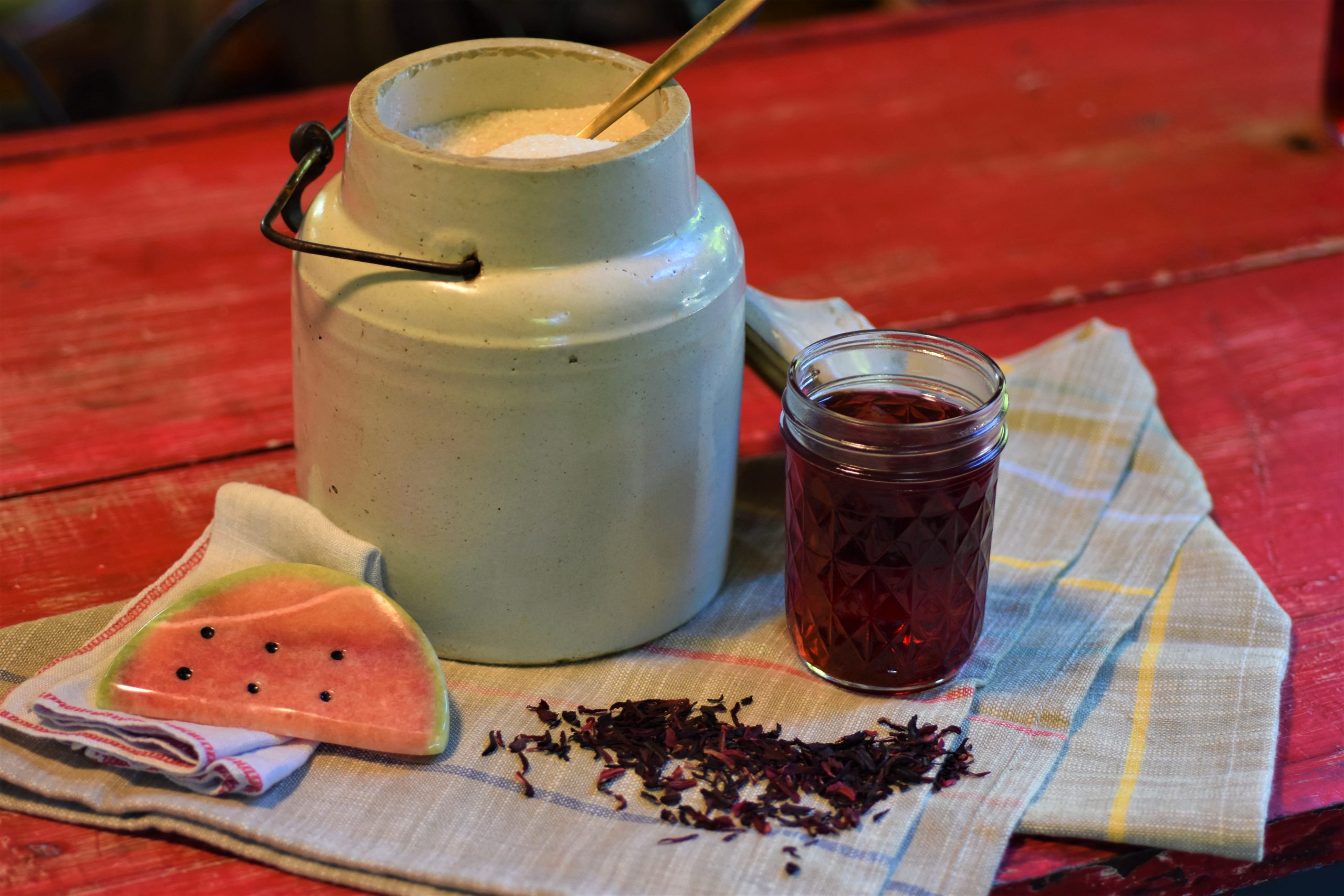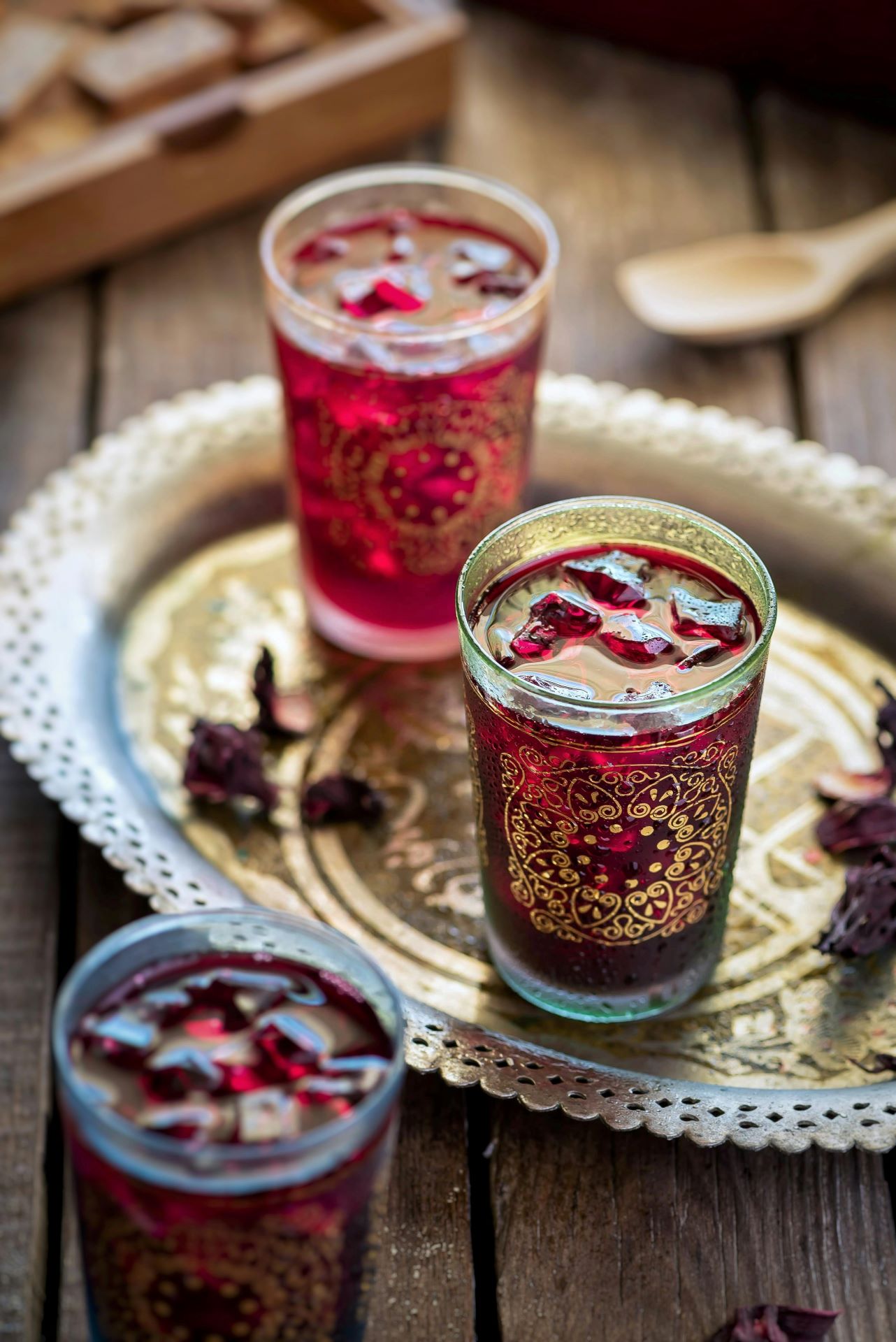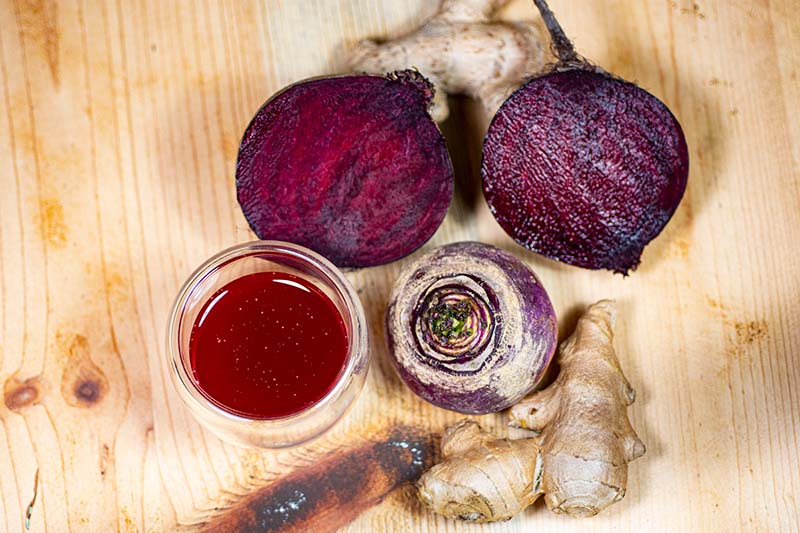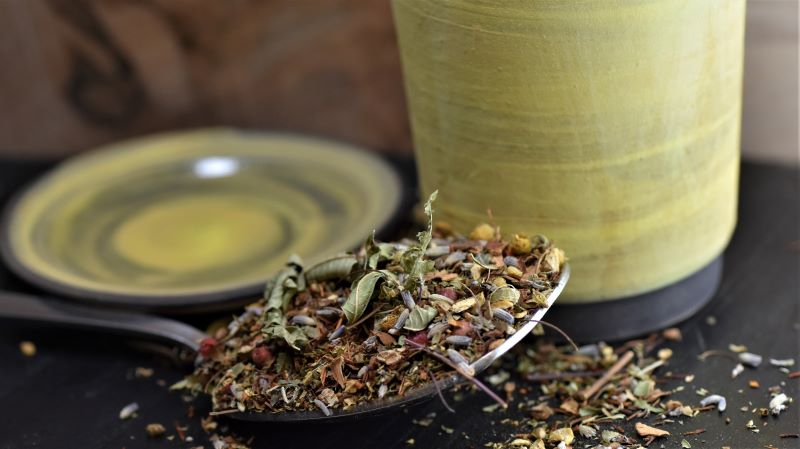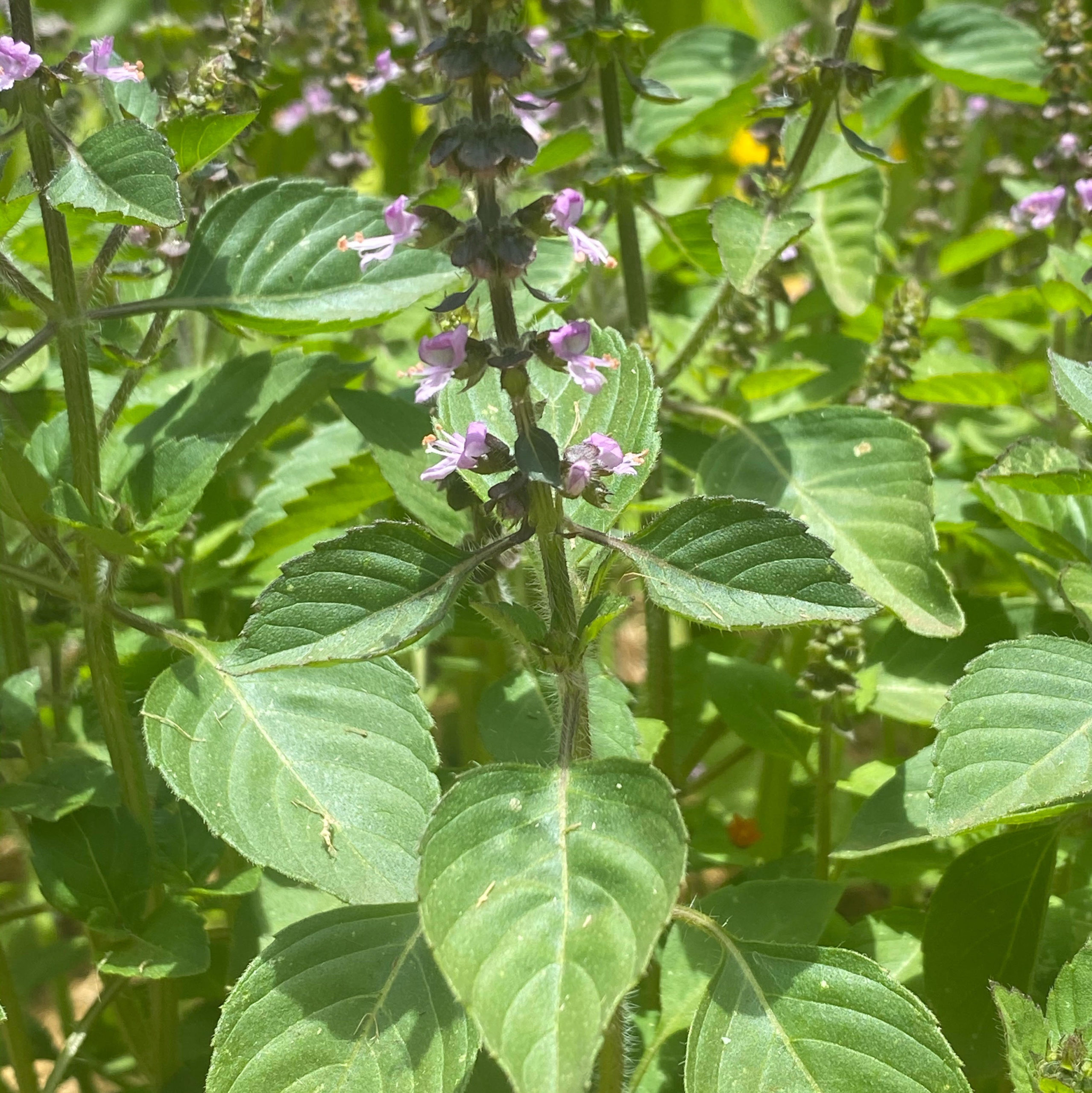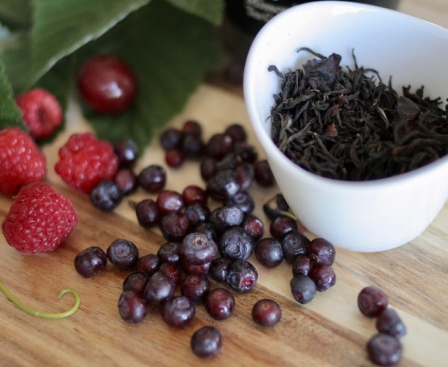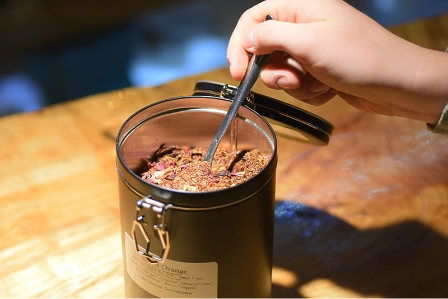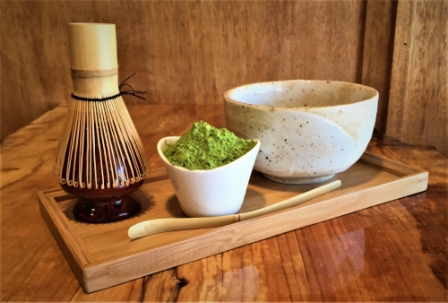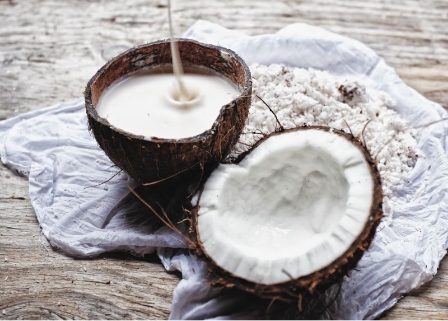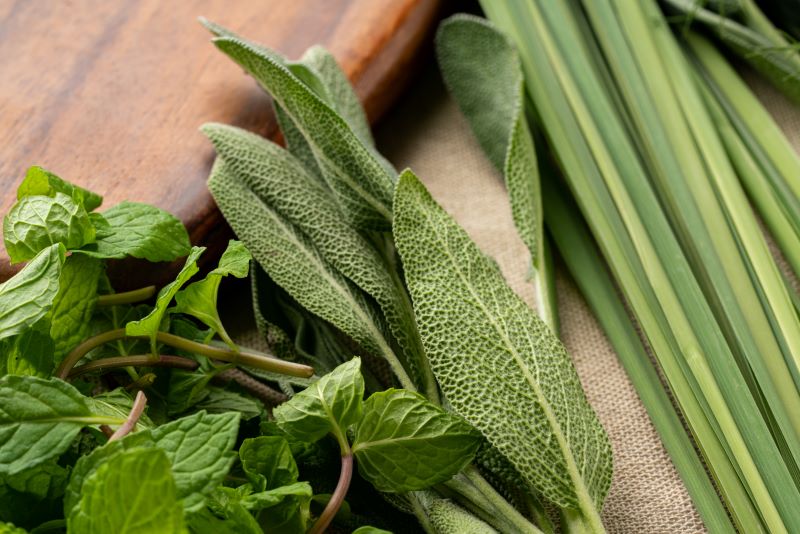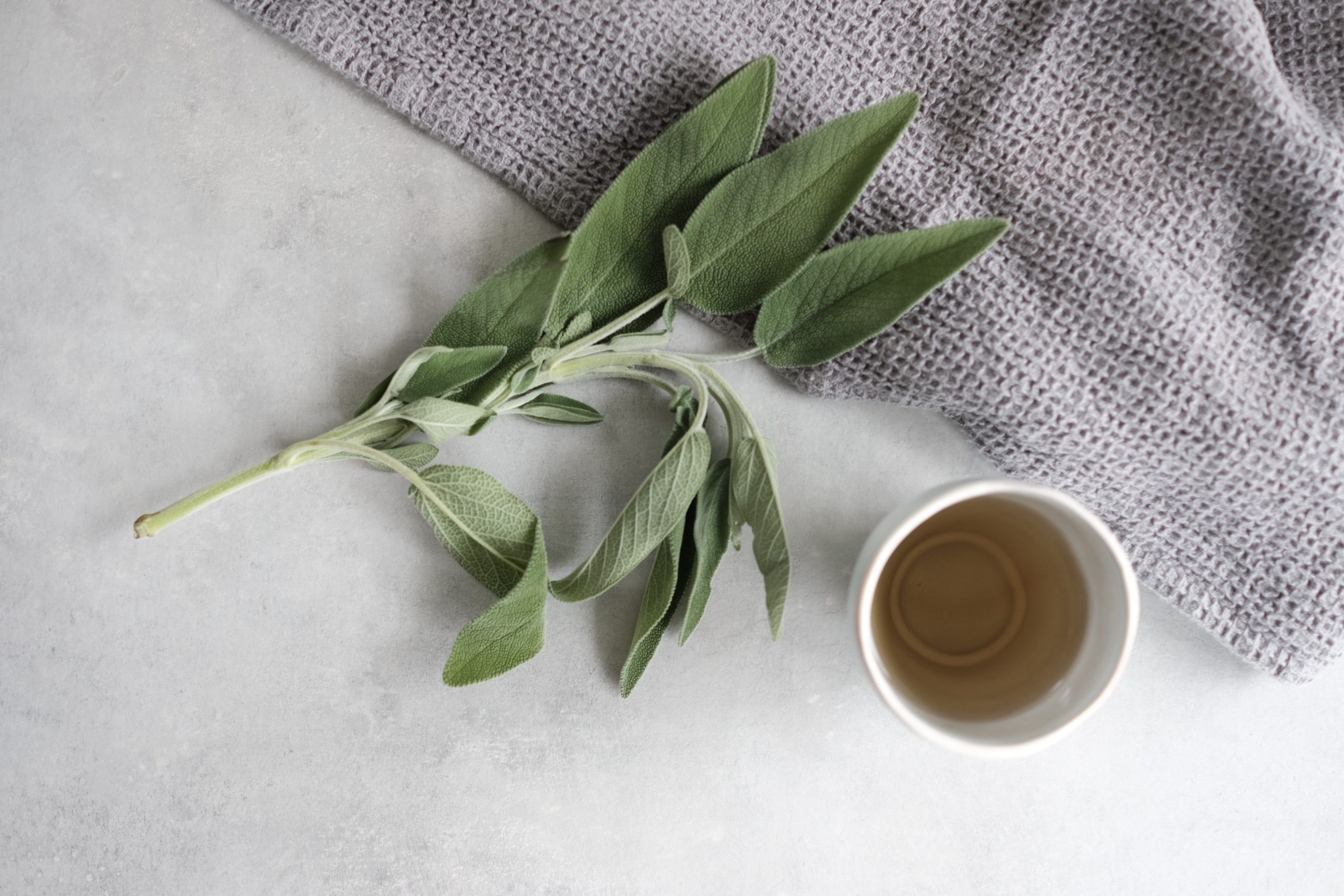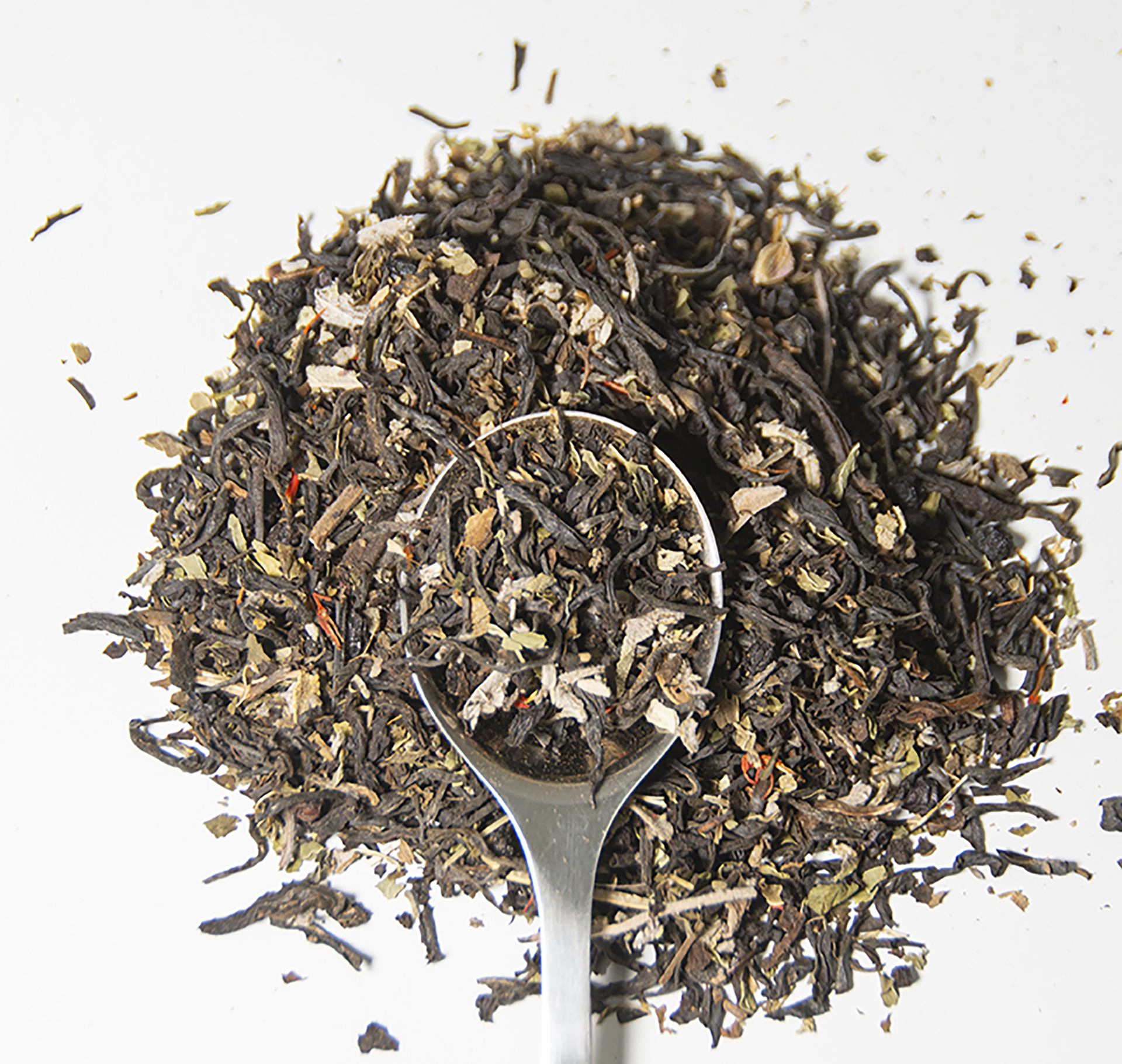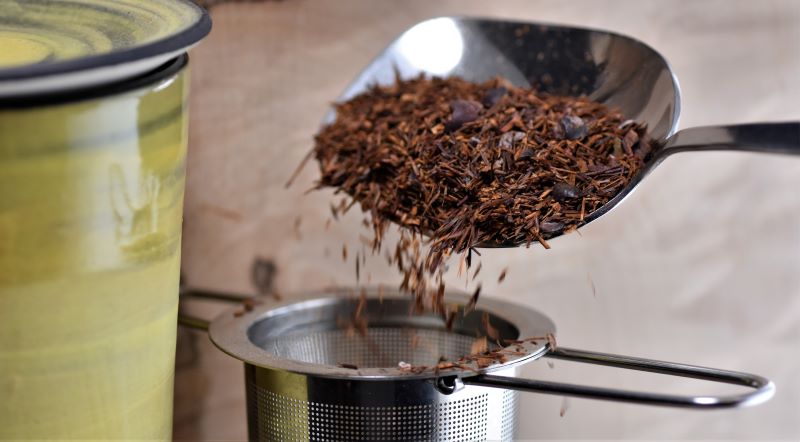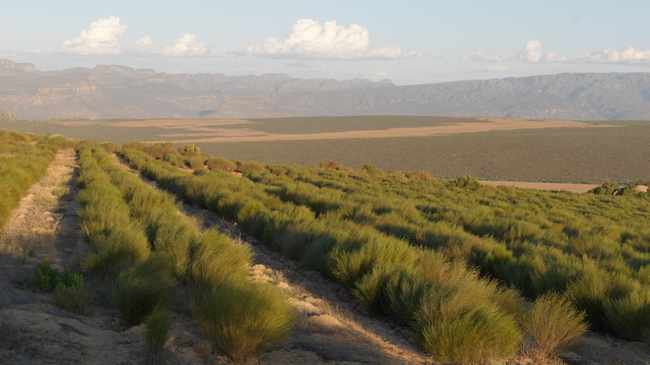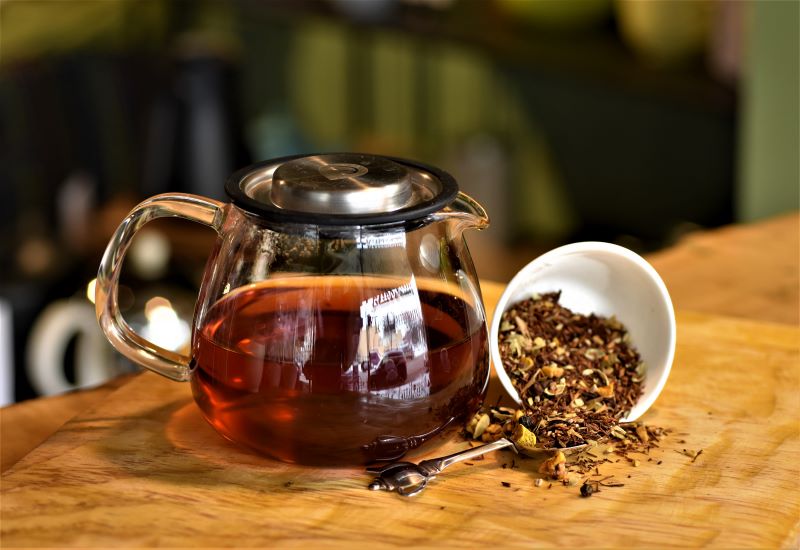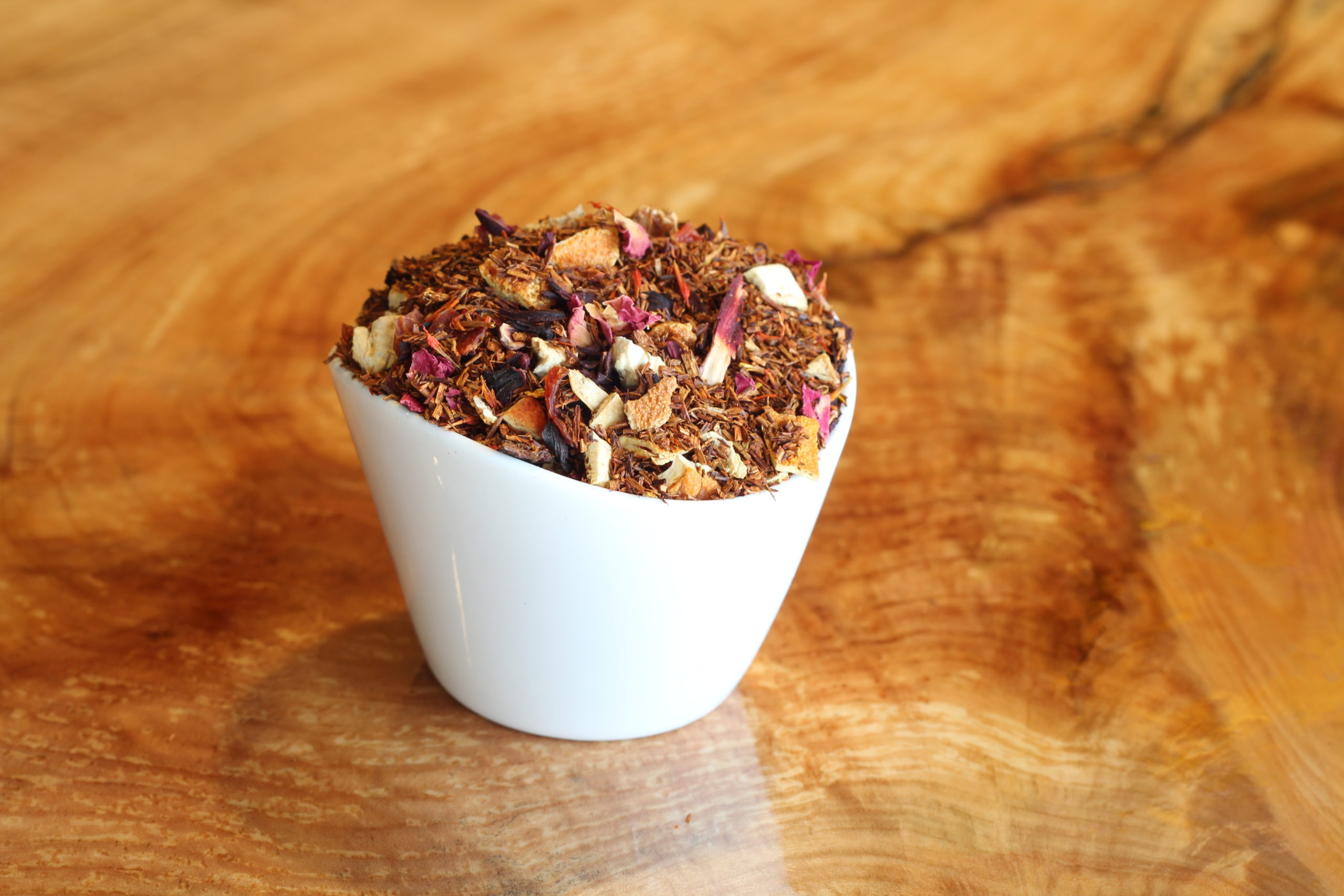Hibiscus Tea and more, by Greta de la Montagne SWSBM alum ‘92, Registered Herbalist(AHG), Gentle Strength Botanicals, and LMTC herbalist consultant
Brew yourself a deep ruby red cup of hibiscus tea, and join me to learn about this large, showy flower in the mallow family!
People drink tea from Hibiscus sabdariffa all over the world, hot or cold. The infusion tastes sour, tart-meets-sweet, like dried cranberry but more complex. It has a lovely citrusy note and a hint of raspberry.
Vitamin C Galore
Hibiscus tea contains 43.6mg of Vitamin C per cup, making it an extremely rich source. Vitamin C does many amazing things in the body! It helps promote a healthy immune system and brain, repair tissue, heal wounds, staunch excessive bleeding, promote the absorption of iron, promote cartilage formation, clean arteries, stabilize blood sugar, and create healthy skin, hair, and nails. Hibiscus is one of the richest plant sources for chromium, and may help stabilize blood sugar levels. Therefore, hibiscus may be especially helpful for hypertension, atherosclerosis, type II diabetes, and metabolic syndrome.
Research suggests that bioflavonoids and Vitamin C have a complementary effect. Brew hibiscus tea with dried rosehips—along with salt and sugar 1:2—for a powerful electrolyte rehydration formula. This pairing has a profound anti-inflammatory and anti-viral effect.
Lake Missoula’s Skin Glow blend incorporates both rosehips and hibiscus. Our Sakura Cherry Green tea blend makes a colorful, sweet-and-tart thirst-quencher. Explore all of our hibiscus blends.
I’m getting thirsty for another cup of hibiscus and rosehip tea right now! If you poured too much of yours, add a splash of Fire Cider, a squeeze of fresh lime, and stick it in the fridge for a tasty shrub cocktail later on in the evening.
Other Health Benefits
Hibiscus is an antioxidant, reducing the damage done by free radicals in the body. Daily antioxidant consumption can lower cancer risk and cardiovascular disease. Hibiscus tea is also high in beta-carotene, anthocyanins, and amino acids.
Primary Actions: Antidiabetic, antihypertensive, antioxidant, mild diuretic, subtle laxative.
Hibiscus tea is good for those suffering from/and:
- blood pressure problems
- heart ailments
- strokes
- obesity
- overcoming mental weakness
- enhancing memory
- strengthening bones
- cardiovascular diseases
- decreases the rate of alcohol absorption, so the juice is a great choice for cocktails
The American herbal products industry (particularly the American Botanical Council, which scans products for adulterants) identified most bulk ascorbic acid used in the vitamin industry is imported from China, where it’s derived from citrus fruits of unknown origin. Synthetic ascorbic acid (the purest form of Vitamin C) used in the oral supplement industry comes from GMO corn and is processed with a host of chemicals including acetone. YUCK! Another good reason to avoid high-cost manufactured supplements. Drink dried hibiscus flower tea from a source you trust.
Extracts of hibiscus have anti-aging effects on the skin. Studies show it prevents and treats melanoma. Hibiscus calyx juice might be beneficial for treating cancer, with all those antioxidants that perform free radical scavenging. Human cell line studies by Akim et al. 2011 show that hibiscus juice may cause cancer cell death, so the extract may have potential uses in cancer-related diseases. The extract can also regulate lipid metabolism and reduce cholesterol levels in the body.
Side effects from hibiscus tea are uncommon, but could include stomach upset, gas, and indigestion. All things in moderation!
A Deeper Dive: cultivation
The hibiscus genus comprises roughly 300 hundred species, native to warm temperate, subtropical, and tropical regions.
Part used: dried calyxes (sepals of a flower) for tea. Leaves are used as an edible vegetable in tropical and subtropical regions around the world, like a spicy version of spinach. Calyxes can be used fresh or candied.
Taxonomy: Each hibiscus flower has both male and female parts. The ovary and other female parts of the flower lie in the main structure of the hibiscus. The pistil, which is long and tubular, has five “hairy” spots at the top that make up the stigma, where pollen is collected.
Other names: Rose/Swamp mallow (eastern US), Ambashthaki (Sanskrit), Karkadeh (Arabic), Florida cranberry, Rose of Sharon (Hibiscus rosa-sinensis), Japakusum (“Japa” in Ayurveda), China rose, Shoeblack plant (Jamaica) “Drink of the Pharaohs” (Egypt), Lalambari (Hindi),
Cottonrose hibiscus (Hibiscus mutabilis): mu fu rong ye (Cottonrose hibiscus leaf, Chinese) Terrengganuu (Malaysia)
Other names for hibiscus tea: Rosella or Roselle (Africa), Agua Fresca de Jamaica (Mexico), soborodo, sorrel drink or sour tea, sorrel(India), Karkade (Egypt), bissap (Senegal)
Cultivation: Rapid germination, will grow in containers or in the ground. Needs full sun and a long growing season. A deep root system makes it drought tolerant. Frost tender, edible leaves, woody perennial, hardy annual, blooms mid-late October. Showy in the garden, with red stems and stalks. Rosella hemp extracted from the stems makes a strong fiber for making sacks, twine, and cords.
Hibiscus and Culture
Other interesting uses: The flowers were traditionally used to polish shoes in Jamaica and some African countries. The juice in the petals is used as shoe-blacking, eyebrow dye, and mascara in China. Native Hawai’ians used the bark to make a dye to disguise their fishing nets and lines. In India, it’s made into a scalp lotion called “stop hair fall” (japakusum); the oil and extract are great for dry hair, alopecia, conditioning the scalp, and stimulating follicular hair growth.
Culture and mythology: Hibiscus is important in Hindu mythology, associated with the goddess Kali, who represents power, transformation, change. It’s considered one of the most auspicious things you can offer to that deity. Hibiscus flowers are sacred to Ganesh, the elephant god and protector of children, the god of wisdom who destroys all obstacles and grants the realization of all goals, who dwells in the first (or root) chakra. Hibiscus flower offerings to Ganesh bring blessings and good fortune. The flowers are important in all pujas (devotional ceremonies) and have a similar energy to lotus and rose flowers. The plant is also part of Polynesian culture, in which a myth links the birth of red hibiscus to the red face of a human. The blossoms are beloved in South Korea and Malaysia, who claim hibiscus as their national flower.
Contraindications: (Based on 2-4 cups ingested/day) May interfere with anti-Malarial drugs. May interact with other drugs used for diabetes and high blood pressure. “Appears safe for all patients to use in tandem with other herbs and pharmaceuticals.” (Dr. Jill Stansbury)
Endnotes
Sources: Web Med, NIH.gov, Wikipedia https://en.wikipedia.org/wiki/Roselle_(plant), “Herbs of Commerce” 3rd edition, AHPA, https://plants.ces.ncsu.edu/plants/hibiscus-sabdariffa/,
“The Yoga of Herbs” by Dr. David Frawley and Dr. Vasant Lad, “Body into Balance” by Maria Noël Groves, “Herbal Formularies for the Health Professionals Vol2, Circulation and Respiration” by Dr. Jill Stansbury, ND,
Further research: https://www.ncbi.nlm.nih.gov/pmc/articles/PMC8834068/#:~:text=Hibiscus%20extracts%20have%20been%20reported,and%20Alzheimer’s%20disease%20%5B43%5D.
Hibiscus extracts are reported to reduce brain pathology and biochemical indices of oxidative stress when injected intraperitoneally into mice in models of Parkinson’s disease and Alzheimer’s disease. Jan 27, 2022.
sorrel drinks: https://pubmed.ncbi.nlm.nih.gov/15383229/
How do herbs affect the body? When people say an herbal tea is “good for you”, what do they mean? How do herbs get into the organs, parts, and structures they’re purportedly “good for?”
And in the words of my teacher, the legendary herbal elder Michael R.S. Moore, we might ask, “How do herbs strengthen weaknesses, redirect excessive tendencies, move fluids, and excite stagnating tissue?”
Although herbs can affect body structure (anatomy), they primarily affect function (physiology): absorption, metabolism, fluid transport, and excretion. Our bodies turn food into energy and structure through a multi-faceted approach, involving chemistry, physics, metabolism, and cellular respiration. Glucose and oxygen are converted into carbon dioxide and water, and the energy released by this chemical reaction is transferred to Adenosine triphosphate (ATP), which powers the cells in your body. Specific proteins control these reactions, and the gut constantly mixes with the fluids we eat and drink. Overall, the process is similar to photosynthesis, albeit sans direct sunlight.
Then the chemistry of herbs is fascinating and complex, involving many phytocompounds. We divide herbs into five major categories: Aromatic (volatile oils), Astringents (tannins), Bitter (phenol compounds, alkaloids, saponins), Mucilagenuos (mucopolysaccharides) and Nutritive (foodstuffs).
Actions, properties, tastes, flavors, energetics… all have an affinity for a particular body system.
One example you should know
Carminative herbs (such as cumin, ginger, or coriander) are typically rich in volatile oils, with fragrant smells that brighten our kitchens. Inside the body, these herbs affect peristalsis of the digestive system, and relax the smooth muscles of the stomach. This supports digestion and the accumulation of gas in the digestive tract. Peppermint is another classic carminative, often used in tea to treat gas and indigestion—along with having a pleasant flavor.
Herbs work best to affect the body in combination with others; we rarely use them one-at-a-time. Herbs can fit into more than one category, and some are slightly neutral.
Herb classifications:
Aromatic—rosemary, lavender, basil, thyme, oregano, sage, coriander, fennel, tarragon, peppermint. Highly concentrated, hydrophobic, and rich with essential oils and volatile resins (i.e. they smell good!). Their actions primarily provoke the gastrointestinal tract, but also affect the reproductive system, and help maintain a clear respiratory tract and lungs. The mechanical action of the oils causes the tissues to expand.
Astringent—blackberry root, green and black tea, oak, yarrow, rose, witch hazel, goldenseal (cultivated only!). Full of tannins, which dry swollen tissue, shrink and create a tighter barrier. Astringents can dry up mucus, and with regular use can strengthen and tone mucous membranes.
Demulcent—marshmallow root, violet, plantain, chia seed, slippery elm (cultivated only!). Contain a slimy “goo” of mucopolysaccharide chains that soothes, protects, and coats the lining of the GI tract and other mucous membrane tissues. They function best in powdered form, or decocted into cold water. Mucous membranes trap abrasive foreign material, and require lubrication with a protective, antibody-rich slime layer propelled by cilia to prevent pathogen invasion in the lungs and subsequent infection.
Bitter —artichoke, dandelion, gentian, hops, orange peel, agrimony, wormwood. Primarily affect the liver and gallbladder, encouraging salivary and bile secretions that help enhance the effectiveness of digestion. Ingesting bitters on the tongue before meals greatly facilitates the breakdown of fats by stimulating peristalsis and bile production.
Alterative—burdock, cleavers, red clover, dandelion, echinacea. Usually taken in higher quantities to stimulate the body’s immune system and fight off an acute infection. Although these herbs are understudied and not well understood, we know they open elimination channels, encouraging the body’s natural detox process. Plains tribes drank huge quantities of echinacea for rattlesnake bite, hence its common name “snakeroot”.
(More on Echinacea)
Americans seized upon echinacea as a cure-all, and in the early 90s, echinacea and goldenseal were the two most popular herbs in the burgeoning homeopathic market. Companies in Germany imported metric tons of echinacea, including it in soaps and shampoos—a nosustainable use of such a potent herb. Semi-flatbeds of Echinacea angustifolia left the eastern-central plains. Thankfully, almost all echinacea on the market today is cultivated Echinacea pallida, (always be sure to check!) The prairies are gradually recovering from overharvesting, but widespread habitat loss continues at an alarming pace. Daily echinacea use is not recommended: you risk running your immune system to the point of exhaustion. Better to support the body with adaptogens, healthy lifestyle, good food, adequate hydration, and exercise.
Herb classifications Part II
Adaptogenic—ginseng family (eleutherococcus, panax ginsengs, aralia) cordyceps, ashwagandha, rhodiola, schizandra. Restoratively affect the limbic system, helping us adapt to excess physical and mental stress. They have a wide range of actions, from helping stimulate mental focus, to enhancing immune system function. These herbs show strong evidence for strengthening weaknesses, and can play a critical role in recovering from a long-standing illness. However, some adaptogens can contribute to adrenal burnout by causing the adrenals to work harder.
Nervine-Sedative—wild oats, skullcap hypericum, chamomile, hops, passionflower. Nourish and support the body’s central nervous system, coating and soothing overstimulated and frayed nerve endings. Calming the nervous system can be great for teething babies and anxious adults lacking sleep. These herbs won’t knock you out, but rather calm and support the body’s natural craving for adequate sleep.
Carminative—angelica, cardamom, anise, caraway, ginger, peppermint. Rich in volatile oils and stimulate the gut to release more contractions. Carminatives aid in the discharge of excessive gas and effectively stimulate peristalsis, relieve sluggish digestion, pacify stomach cramps, and promote smooth digestion. A pinch of cardamom will help counterbalance and neutralize the gut-lining effect of strongly astringent herbs, like black tea or coffee.
Diuretic—dandelion, parsley, nettle, cleavers, green tea. Stimulate the kidneys, relax the bladder and help us urinate. They can cause rapid movement of fluids if applied correctly and in concert as in a tea blend. Overuse can irritate the kidneys—as anyone who has drunk uva-ursi tea can attest to.
Herb classifications Part III
Diaphoretic—elderflower, garlic, ginger, yarrow, boneset, cayenne. Help raise the body temperature and induce involuntary perspiration, send heat out to the periphery, stimulate circulation, open skin pores, and excite sweat glands. They can greatly speed the elimination of toxins from the system. If the river eddies are backed up with flotsam, the water can’t flow, and a clean flowing lymph system is our “river of life”, crucial for our immunity. Some diaphoretics can relax tense, tight tissues, while others can stimulate and open up capillary beds, bringing heat stuck in the core to the outside periphery.
Emollient—plantain, violet, calendula, aloe vera, licorice, slippery elm, borage. Similar to demulcents, but help soothe and soften irritated skin. They’re typically used in skin creams and salves.
Expectorant—elecampagne, horehound, yerba santa, linden. Contain volatile compounds that enter through our blood into our lungs to be exhaled and help clear our airway by breaking up impacted mucus. Some are very energetic and warming, and can quickly cause highly productive coughing. Some are more mucilaginous and soothing.
Summary
Under stress or illness, our bodies naturally tend toward healing and homeostasis. But stresses can slow the process, including inherited and acquired weaknesses, environmental stress, and the exogenous chemicals in our food and water. Drinking herbal teas can positively affect the body, counterbalancing those obstacles, and speeding the body back towards healthy balance.
Hopefully I’ve illustrated how an herb can affect a particular organ or tissue through the body’s digestive and absorptive actions. Processed like food, alongside what we eat, our hunting-and-foraging bodies have ingested herbs as food for ages. Through generations of trial and error and passing down that information, we have discovered and identified particular plants that are good for healing upset tummies, reducing inflammation, or soothing a headache.
All the hormonal signaling that goes on when we drink a simple cup of tea can be mind-boggling to dwell on. Perhaps the most important nugget is that herbs affect the body by helping calm the elevated or chronic stress responses that degrade us.
May your next cup of tea take your mind into some new territory, thinking about all these functions and messages inside the body!
And of course all of this information comes with a standard health disclaimer: if you intend to treat yourself, I encourage you to visit your local trained and professional herbalist for a complete health evaluation, with subsequent suggestions and recommendations.
Written by Greta de la Montagne, LMTC Herbalist Consultant
References:
“Herbal Energetics in Clinical Practice” Acrobat file in SWSBM.com
Link to Herb Energetics Chart: https://www.swsbm.com/ManualsMM/HRBENRGT.pdf
Eleutherococcus study in Russia: https://pubmed.ncbi.nlm.nih.gov/34087398/
The interaction between respiratory pathogens and mucus: https://www.ncbi.nlm.nih.gov/pmc/articles/PMC4752725/
United Plant Savers Species-At-Risk List: https://unitedplantsavers.org/species-at-risk-list/
UpS list of Herbs and Analogs: https://unitedplantsavers.org/wp-content/uploads/2022/05/22279-UpS-Herb-Analog-List-by-Jane-Bothwell_rev2006.pdf
Heavy Hitters for 2022
We wanted to share our most popular Lake Missoula teas for this past year, 2022. While we have over 150 blends and teas, these rise to the top. By tea type:
Black Tea
Our top black blends are: Earl Grey Blue, High Country Huckleberry, and Lake Missoula Breakfast. Many of our customers appreciate the premium single origin teas we offer: Dom Dom Bodo Assam from India, Mammoth Red from Indonesia, and Nepali Gold from Nepal are high quality teas grown by artisan farmers!
Botanical (Herbal)
Our best selling caffeine free blends are: Spicy Ginger Snap, Sun-Kissed Huckleberry, Pleistocene Peach, and Stress Less. The consumers of our single botanicals know what’s good for them. These teas offer relief and aid in health: Kava Kava, Immortality Herb, and Ginger Root.
Rooibos
Rooibos is also caffeine free, but like true tea, it’s full of antioxidants. We think it deserves its own category for its distinct flavor and goodness. Blood Orange, Gin & Cream, and Turmeric Twirl were the winners here.
Oolong
Oolong tea sits between green and black. The two top blends were Creamy Coconut and Mimosa Oolong, while the single origin top dog was Lake Missoula’s Black Pearl from Sumatra.
White
Cloud 9 Montana (aka our “A White Christmas”) and Alpine White take the torch! Our customer’s refined palate recognizes quality ingredients when they taste them.
Puerh
This was no surprise to us: Sticky Rice and Jasmine Puerh were at the top with our dark teas.
Green
The least manipulated leaf is green tea. We have so many good greens, and our customers know it. This all-organic list includes: Lemon, Lavender, Love; Morrocan Mint, and Jurassic Ginger. Mammoth Matcha and Heritage Green are the single origin winners.
Chai
We had three at the top for chai: Evening Chai (caffeine free), Golden Milk (actually a turmeric spice mix), and autumn seasonal Harvest Moon.
That wraps up our list of most popular 2022 teas! Are any of these your favorites?
Written by: Heather Kreilick
Sage makes wonderful tea! Most people know Salvia officinalis as a highly aromatic culinary spice, especially good to preserve and help digest meats. But don’t relegate it to the spice cabinet! Sage has potent antibacterial and antiviral properties, and is anti-inflammatory, antispasmodic, astringent, decongestant, carminative, and a good nervine.
Historical View
Bitter and pungent in flavor, sage has been utilized to ensure a long life. An ancient Latin proverb, dating to at least the early Middle Ages, goes: Cur moriatur homo cui Salvia crescit in horto? (Why should a man die when sage flourishes in his garden?)
It was traditional in England to eat sage in May to ensure good health throughout the year: He who would live for aye, Must eat sage in May. Fresh sage and parsley were chopped, mixed with butter and salt, and spread on daily sandwiches or cooked with potatoes.
Medicinal Uses
Sage’s aromatic oils can stimulate the pituitary gland, the adrenals, the reproductive hormones, and the body’s immune system. It helps dry excess mucus in the respiratory tract, reduces sweating, and can prevent lactation. Sage can be used in moderation for irregularity of the menstrual cycle, and is particularly valuable in cases of heavy cycles.
Warming and drying by nature, sage in the form of a tea or topical poultice is ideal for treating rheumatic pains caused by cold, damp weather. Sage also promotes circulation and has a strong reputation for helping memory. Carry a leaf of sage in your pockets to promote wisdom and also to protect you from the plagues!
Use sage topically as a fomentation, poultice, wash, or foot bath. It is a reliable disinfectant to help treat staph infections, athlete’s foot, cuts, abrasions, and wounds. Washing the face with sage tea is highly effective for treating acne and oily skin. In fact, it was a primary ingredient in the “Queen of Hungary Water” from the 1300’s, the world’s first known distillable perfume and cure-all beauty tonic, with rosemary, chamomile and rose in apple cider vinegar.
Contraindications are few. Except for culinary use, avoid sage during pregnancy and lactation due to the high ketone content, but use it to help conception or a baby to “stick” to a slippery and cold uterus. Large doses can cause dryness of the mouth and mucous membranes. Individuals prone to seizures should avoid sage essential oil.
Sage Teas
The most pleasant way to take sage to help your memory or fight a virus is to drink a cup of sage tea daily. Use a sprig of fresh sage or a rounded teaspoon of dried leaves per cup of boiling water, cover and allow to brew for up to a minute. This method will elicit a slightly diaphoretic effect, causing sweating. Consume the tea cold or at room temperature as an astringent and antihidrotic (perspiration inhibitor). This method can help treat night sweats, hot flashes and excessive sweating, and can aid in drying mucous membrane secretions.
Sage tea with lemon and honey is particularly good for drying out phlegmy, wet coughs. Gargle warm sage tea for sore throats, or add a little sea salt or apple cider vinegar. Regular consumption of sage, either as a tea or mouth rinse, can relieve gum diseases and mouth infections.
Integrate sage into your tea drinking with two of our teas. Our Silurian Sage is a black tea blend that contrasts the earth notes of sage with bright peppermint, resulting in a savory and stimulating sensation in the mouth. And our single botanical sage features this powerful herb by itself, which you can steep following the guidelines in this article!
Read new quarterly herbalism content by Greta de la Montagne on our blog page.
Written by: Greta de la Montagne Edited by: Samantha Lepore & Heather Kreilick
Rooibos / Red Bush / Bush Tea Aspalathus linearis
Rooibos (pronounced ROY-boss), both healthy and caffeine-free, makes one of our favorite drinks. You may know it as South African Red Tea, Red Bush, Bush Tea, Mountain Tea, and “Red Gold.” Hints of vanilla make a lovely cup to enjoy with milk and honey on a chilly evening around the fire. Steep seven minutes minimum for optimal extraction of the phytonutrients and rich minerals in rooibos.
Medicinal Uses
Rooibos has long been drunk in Africa as both a refreshment and a healthy tea beverage. Said to alleviate symptoms of seasonal allergies, eczema, and arthritis, and aides with anti-aging and weight loss. May provide relief for palliating stomach cramps and diarrhea, especially colic in babies. Recent scientific studies show that rooibos helps with diabetes, heart health, digestion, and bone health. Its medicinal actions include: anti-inflammatory, immunomodulation, antispasmodic, bronchiodilator, lowers hypertension (blood pressure), antimutagenic, antidiabetic, and limits adrenal hormone production, such as cortisol. There are no known precautions with consuming this plant, which is caffeine-free, low in tannins, and high in antioxidants.
Historical View
The San tribe has a long ethnobotanical history of using this plant, and the Khoi tribe to a lesser extent. Taken with honey and fresh goat milk, it helps people sleep deeply. Afrikaans people brew it until it is so thick, you can hardly see the bottom of the cup. In many farmhouses, people simmer a handful of leaves on the stove for the entire day, and add more water as people consume it.
The Khoisan peoples shared their traditional knowledge with early Dutch colonizers. The Dutch renamed it “rooibos” or “red bush” and drank it in place of expensive black tea from England. Unfortunately, ethnobotanical records of rooibos do not exist more than 300 years ago, and no Khoi or San vernacular names have ever been recorded. All the common names of the Aspalathus linearis to date are of Afrikaans, Dutch, or English origin. These names include rooibos, naaltee, swarttee, koopmanstee, bossiestee, and bush tea.
Harvesting
The plant is a shrub-legume in the Fabaceae family (Pea family). When the needle-like leaves and tiny yellow flowers are picked, bruised, and oxidized, the leaves turn a reddish color, hence its name. Green rooibos, like green tea, dries without oxidation.
The harvest process resembles that of Camellia sinensis. The top 50cm of the plant is harvested annually during summer (December to February). Traditionally, pickers used sickles and bundled by hand, but mechanization now predominates. The needle-like leaves are bruised, oxidized, and left to dry in the harsh South African sun, where they turn a distinctive orange-red color. 10,500 tons of rooibos are harvested annually to serve the global market.
Exceedingly mineral-rich, rooibos was commercially cultivated since about 1994, and is one of the few wild species developed as a commercial crop. It takes 18 months for the plant to mature for harvest, and farmers replace the crop every 5-7 years. There are concerns regarding rooibos farming in the face of climate change.
Ecological View
The rooibos plant is endemic to a region of the Western Cape province of South Africa, in a 20,000 square kilometer biodiversity hot spot called the Fynbos biome, or Suid Bokkeveld. The area, Cederberg/Clanwilliam, lies 250 km north of Cape Town. It grows symbiotically with local microorganisms in a mountainous area with a unique temperature range, with a particular deep, well-drained acidic and coarse sandy soil. Bacteria create nodules on the roots, fixing the atmospheric nitrogen, which is conducive to neighboring plant growth.
Rooibos Teas
Lake Missoula has many healthy, caffeine-free teas that feature rooibos. Our Blood Orange Rooibos balances the vanilla notes of rooibos with juicy, mouthwatering citrus. Then Cape Town Grey is our caffeine-free take on a classic Earl Grey, with its bold, bergamot flavor. Gin & Cream Rooibos features notes of juniper, lavender, and vanilla, creating a unique taste with every sip. And our Rugger’s Rooibos is a straight Rooibos tea that showcases this African plant to its fullest.
Read new quarterly herbalism content by Greta de la Montagne on our blog page.
Written by: Greta de la Montagne, Edited by: Samantha Lepore & Heather Kreilick


